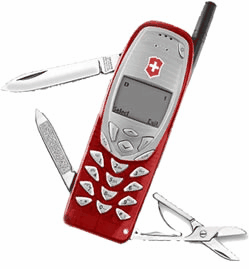 The price people are willing to pay for software, hardware or mobile phones is coming down. In turn, Microsoft and Nokia are facing new threats, while Apple may not enjoy its iPhone honeymoon much longer.
The price people are willing to pay for software, hardware or mobile phones is coming down. In turn, Microsoft and Nokia are facing new threats, while Apple may not enjoy its iPhone honeymoon much longer.
These days one can purchase a computer for Euro 400 or less. The machine may give you 2GB of RAM. So why should one pay between Euro 150.00 to 250.00 for an operating system, such as Windows Vista? Similarly, why pay Euro 400 for an expensive mobile phone from Nokia or Apple when a cheaper option is available?
Since certain software such as OpenOffice.org or Google’s Picasa is free, people are beginning to resist higher price tags. Moreover, cheaper mobile phones are gaining market share.
MICROSOFT CHANGING ITS PRICING STRATEGY
In the U.S. Microsoft has confronted this by creating the “Student and Teacher” version of Office. One can purchase Word, Excel and PowerPoint (not Outlook) for $129. Nobody checks if you go to an evening course once a week or your kid is in Kindergarten. If you feel you qualify for the Student and Teacher version – so you do. That simple. Nobody is stopping you from buying the Student and Teacher version.
The same has happened with Windows Vista in retail stores. The prices for the Premium edition (now $129 instead of $159) and the Ultimate ($219, down from $299) have been lowered.
However, Microsoft is not the only firm that has to re-consider its high profit margins and question how much longer this kind of business model can continue to thrive. So are mobile handset manufacturers.
ZTE Corp. FORCING NOKIA, RIM TO CHANGE PRICING
ZTE Corp., the Chinese telecoms equipment maker is starting to give rivals such as Nokia a run for their money.  ZTE has struck deals with operators including Vodafone to provide handsets for emerging markets such as India at Euro 35 or less. Those phones are available for customers with pre-paid SIM cards as well. They do as much or more than some high-end phones may have offered clients a couple of years back.
ZTE has struck deals with operators including Vodafone to provide handsets for emerging markets such as India at Euro 35 or less. Those phones are available for customers with pre-paid SIM cards as well. They do as much or more than some high-end phones may have offered clients a couple of years back.
If you cannot see the image get it here:
a step that moves us toward the Swiss Army phone
Google’s 2007-11 announcement about its “Android” platform, aiming to bring the full power of desktop computing to mobile devices is another change in the market.
Again consumers considering the purchase of an iPhone or a Blackberry may start to resist their relatively high prices.
BOTTOM LINE
There are two things at work here:
1) the price people are willing to pay for software, their PC, handheld or mobile is coming down;
2) computing in a cloud (Choose option Login as Guest, click on the link again to get free access) services are making the necessity of having huge processing power on your desktop or mobile unnecessary, pushing hardware prices for notebooks and mobiles ever lower.
The open source movement combined with computing in a cloud (Choose option Login as Guest, click on the link again to get free access), advertising-supported software and services, epitomized by Google and others, are starting to have the long-predicted effect.
Microsoft is already trying to limit the damage by getting into the virtualization and offering software needed for computing in a cloud (Choose option Login as Guest, click on the link again to get free access) with its Windows 2008 Server. You find more details about how Microsoft is muscling into this market and what it means for reliability and dependability of YouTube, Facebook and corporate services here:
Hypervisor is not ready before October 2008
| If this post was helpful to you, please consider stumbling it or Digg this ComMetrics post from CyTRAP Labs. | |
| Also of interest: | |
| getting your corporate blog noticed – pretending not to care | why women buy black high heels – the girl’s guide |
| the mission of ComMetrics | we don’t nickel and dime you |
TIDBITFebruary 2008, Vodafone, Verizon Wireless and China Mobile began trials in China, Europe and US with a handset that would allow ‘roaming the world’. The handset is based on 4G wireless technology, also known as LTE – Long Term Evolution.
Comments on this entry are closed.